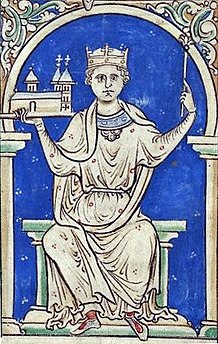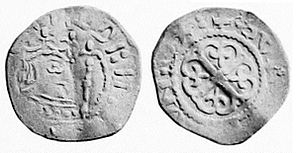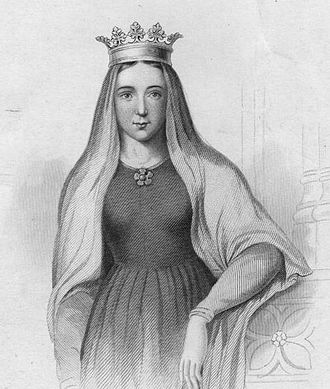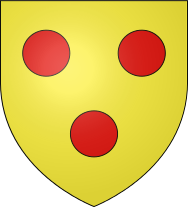
I have always been fascinated by the story of The Anarchy, that period of civil war in 12th century England. Empress Matilda fought her cousin, King Stephen, for the crown of England and the Anglo-Saxon Chronicle famously reported:
… they said openly that Christ and His saints slept. Such things, and more than we know how to tell, we suffered nineteen years for our sins.
The Anglo-Saxon Chronicles, edited and translated by Michael Swanton, p.265
King Stephen of England and his wife, Matilda of Boulogne, had three children who survived infancy, and yet – on his death – Stephen disinherited his surviving son, William, to leave his throne to Henry, Count of Anjou and Duke of Normandy. Henry was the son of Stephen’s bitter enemy, Empress Matilda.
Matilda of Boulogne, herself, was a cousin of Empress Matilda through her mother, Mary of Scotland, sister to the empress’s mother, Matilda of Scotland. Matilda of Boulogne and Empress Matilda were both granddaughters of Malcolm III of Scotland and his saintly wife, Margaret of Wessex; they were nieces of King David I of Scotland.
The Empress was was the only surviving legitimate child of Henry I (reigned 1100-1135), and his designated heir – but she was a woman and England’s nobles were reluctant to be ruled by a woman. This reluctance to allow Matilda to take the throne was heightened by their dislike and distrust of Matilda’s husband, Geoffrey, Count of Anjou. Stephen of Blois was Henry I’s nephew and the son of Henry’s favourite sister, Adela of Normandy. He was one of the old king’s closest male relatives and in the confusion following Henry’s death it was Stephen who took the initiative, acting quickly and decisively, and taking the kingdom of England and the duchy of Normandy for himself.

What followed was a period known as the Anarchy, almost twenty years of conflict and bloodshed as Stephen and Matilda battled for supremacy. Ultimately, Stephen managed to retain control of England but Matilda’s eldest son, Henry, was eager to win back his birthright.
Following several incursions by Henry – whilst still in his teens – he and Stephen came to an agreement: Stephen would hold the throne until his death, but Henry would succeed him.
So, what happened to Stephen’s children?
Stephen and Matilda had two children, Baldwin and Matilda, who did not survive to adulthood. Matilda was married in 1136, as an infant, to Waleran de Beaumont, eldest twin son of Robert de Beaumont, 1st Earl of Leicester, and Isabel de Vermandois. The poor little girl died the following year, aged only 4.
Eustace IV, Count of Boulogne
The eldest surviving son of Stephen and Matilda was Eustace IV, Count of Boulogne. Eustace was an unpleasant character, by most accounts. The Anglo-Saxon Chronicle called him ‘an evil man’ who ‘robbed the lands and laid heavy taxes upon them’. Henry of Huntingdon’s appraisal of Eustace was almost as damning:
… he was a man proven in military skill, but obdurate against the things of God, very harsh towards the incumbents of churches, very loyal towards those who persecute the Church.
The History of the English People 1000-1154 by Henry of Huntingdon
Eustace was married in Paris, in 1140, to Constance, the only daughter of Louis VI of France and his second wife, Adelaide of Savoy. She was the sister of King Louis VII, the first husband of Eleanor of Aquitaine. Constance ‘was a good woman but enjoyed little happiness with him’. According to the Anglo-Saxon Chronicle:
1140. Then Eustace the king’s son travelled to France and took to wife the sister of the king of France and thought to get Normandy through that, but he had little success, and with just cause, because he was an evil man, because wheresoever he came he did more evil than good; he robbed the lands and laid great taxes on them. He brought his wife to England and put her in the castle at Canterbury. She was a good woman but she had little happiness with him, and Christ did not wish that he should rule long, and he [1153] and his mother [1152] both died.
The Anglo-Saxon Chronicles, edited and translated by Michael Swanton, p.267

Stephen made attempts to have Eustace crowned, in his own lifetime, as heir-designate, in order to guarantee his succession. This was blocked by the Papacy; though they supported Stephen as king, over Matilda, they were keen to see the throne return to the senior legitimate line of Henry I through Matilda’s son, Henry.
The young prince had retired from court after a thawing of relations between Stephen and Henry. He was;
‘greatly vexed and angry because the war, in his opinion, had reached no proper conclusion’.
Gesta Stephani
Although Eustace had been recognised, as Stephen’s heir, by the secular baronage, I can’t help thinking that it was a real stroke of luck for England when Eustace died of a seizure or ‘in a fit of madness’ in August 1153. He had recently laid waste to the lands of the abbey of Bury St Edmunds and so some said the revered saint had exacted his revenge. Another theory was that he choked to death and, of course, rumours of poisoning are not surprising. Eustace’s death paved the way for an ‘understanding’, over the succession, between Stephen and Henry of Anjou, in the form of the Treaty of Winchester (or Wallingford, as it is also known). In it, it was agreed that Stephen would remain king for the rest of his life, but would ‘adopt’ seventeen-year-old Henry and recognise him as his heir.
William, Earl of Surrey
Stephen’s youngest son was William, who was born sometime in the mid-1130s. It is thought William was born following Stephen’s accession to the English throne in 1135, as he was named after his great-grandfather, William the Conqueror, King of England and Duke of Normandy, rather than with a name associated with the County of Boulogne, as had his older brothers, Eustace and Baldwin.

In 1148 he was married to Isabel de Warenne, sole heiress to William de Warenne, 3rd Earl of Surrey, in order to bring the vast Warenne lands within the influence of the crown. Isabel’s father had departed on the Second Crusade in 1147 and would not return, being killed at the Battle of Mount Cadmus, in Laodicea, in January 1148. Young William was being addressed as an earl even before his father-in-law’s death.1 He would succeed to the County of Boulogne in 1153, on the death of Eustace and the county of Mortain on the death of his father in 1154.
Shortly after his brother’s death, and with the help of the clergy, William made an agreement with Henry of Anjou, whereby he waived his own rights to the crown in return for assurances explicitly recognising his rights to his lands, as Count of Boulogne and Earl of Surrey. Although, it is not known whether he did this willingly, or was persuaded by others, the agreement was an essential tool for the peaceful accession of Henry.
In spite of this agreement, William was implicated in a plot against Henry in early 1154 – or he at least knew about it – in which some Flemish mercenaries planned, but failed, to ambush Henry on the road near Canterbury. There may have been a tit-for-tat retaliation as William’s leg was broken in an ‘accident’ at about the same time.
However, when King Stephen died, William made no attempt to oppose Henry’s accession. In the early years of his reign, Henry acted to curb some of the power and influence William may have wielded by confiscating some of the lands and castles from his patrimony of Mortain, but allowing him to retain the earldom of Surrey, for the most part. William was even knighted by Henry II, after he joined the new king on his campaign against Toulouse.
William died in France, without issue, in 1159, after falling ill at the Siege of Toulouse and was buried in the Hospital of Montmorillon in Poitou, France. He was in his early 20s and left his young wife, Isabel, about the same age, a widow.
Mary of Boulogne

William was succeeded in the County of Boulogne by his sister, Mary, the third surviving child of Stephen and Matilda. Mary was born around 1136 and placed in a convent at an early age. Although it has long been believed that Mary was placed in a convent in England, it now seems likely that she was placed at St Sulpice in Rouen before moving to England in the early 1150s.2 She moved first to the Priory of Lillechurch, Kent, and then to Romsey Abbey, where she was elected Abbess sometime before 1155.
Five years later – shortly after William’s death – Mary was abducted by Matthew of Alsace, second son of the Count of Flanders, and forced to marry him. There was outrage among the clergy – the incident was even discussed by the Pope – but the marriage was allowed to stand, at least until Mary produced an heir to the county of Boulogne. Mary and Matthew had two children – Ida and Mathilde – and it was after the birth of Mathilde that the couple was divorced, in 1170.
Matthew would continue to rule Boulogne and would eventually be succeeded by Ida, his eldest daughter by Mary, on his death in 1173. Mary was allowed to return to the convent life, becoming a Benedictine nun at St Austrebert, Montreuil. She died there in July 1182, aged about 46.
The abduction and forced marriage of Mary may well have been a political move. Although there does not appear to be any proof that Henry II sanctioned it, he certainly benefited from Mary being safely married to a loyal vassal. She was, after all a great heiress and – through her father – a rival claimant to the throne of England.
It is, perhaps, a sad legacy for King Stephen that, after almost 20 years of warfare in order to hold onto his throne, the king was not able to pass it on to any of his children. His sons dying without issue meant that his bloodline continued only through his daughter, Mary, and the County of Boulogne, which Stephen had inherited through his marriage to Matilda.
*
Footnotes: 1 Farrer, William and Charles Travis Clay, editors, Early Yorkshire Charters, Volume 8: The Honour of Warenne; 2 with thanks to historian Sharan Newman
Further reading:
Donald Matthew, King Stephen; Robert Bartlett, England Under the Norman and Angevin Kings; David Williamson, Brewer’s British Royalty; the History Today Companion to British History; Dan Jones, the Plantagenets; englishmonarchs.co.uk; The Oxford Companion to British History; Mike Ashley, The Mammoth Book of British kings & Queens; Alison Weir, Britain’s Royal Families, the Complete Genealogy; Farrer, William and Charles Travis Clay, editors, Early Yorkshire Charters, Volume 8: The Honour of Warenne; Gesta Stephani; Henry of Huntingdon, The History of the English People 1000-1154; J. Sharpe (trans.), The History of the Kings of England and of his Own Times by William Malmesbury; Catherine Hanley, Matilda: Empress, Queen, Warrior; Orderici Vitalis, Historiae ecclesiasticae libri tredecem, translated by Auguste Le Prévost; Chronicles of the Reigns of Stephen, Henry II and Richard I; Edmund King, King Stephen; Donald Matthew, King Stephen; Teresa Cole, the Anarchy: The Darkest Days of Medieval England; Matthew Lewis, Stephen and Matilda’s Civil War: Cousins of Anarchy.
Pictures courtesy of Wikipedia
*
My Books
Signed, dedicated copies of all my books are available through my online bookshop.
Coming 15 January 2024: Women of the Anarchy
On the one side is Empress Matilda, or Maud. The sole surviving legitimate child of Henry I, she is fighting for her birthright and that of her children. On the other side is her cousin, Queen Matilda, supporting her husband, King Stephen, and fighting to see her own son inherit the English crown. Both women are granddaughters of St Margaret, Queen of Scotland and descendants of Alfred the Great of Wessex. Women of the Anarchy demonstrates how these women, unable to wield a sword, were prime movers in this time of conflict and lawlessness. It show how their strengths, weaknesses, and personal ambitions swung the fortunes of war one way – and then the other.
Available for pre-order from Amberley Publishing and Amazon UK.
Coming on 15 June 2024: Heroines of the Tudor World
Heroines of the Tudor World tells the stories of the most remarkable women from European history in the time of the Tudor dynasty, 1485-1603. These are the women who ruled, the women who founded dynasties, the women who fought for religious freedom, their families and love. These are the women who made a difference, who influenced countries, kings and the Reformation. In the era dominated by the Renaissance and Reformation, Heroines of the Tudor World examines the threats and challenges faced by the women of the era, and how they overcame them. Some famous, some infamous, some less well known, including Anne Boleyn, Elizabeth Barton, Catherine de Medici, Bess of Hardwick and Elizabeth I. From writers to regents, from nuns to queens, Heroines of the Tudor World shines the spotlight on the women helped to shape Early Modern Europe.
Heroines of the Tudor World is now available for pre-order from Amberley Publishing and Amazon UK.
Also by Sharon Bennett Connolly:
King John’s Right-Hand Lady: The Story of Nicholaa de la Haye is the story of a truly remarkable lady. Nicholaa de la Haye was the hereditary constable of Lincoln Castle and the first woman in England to be appointed sheriff in her own right. Her strength and tenacity saved England at one of the lowest points in its history. Nicholaa de la Haye is one woman in English history whose story needs to be told… King John’s Right-Hand Lady: The Story of Nicholaa de la Haye is now available from Pen & Sword Books, bookshop.org and Amazon.
Defenders of the Norman Crown: The Rise and Fall of the Warenne Earls of Surrey tells the fascinating story of the Warenne dynasty, of the successes and failures of one of the most powerful families in England, from its origins in Normandy, through the Conquest, Magna Carta, the wars and marriages that led to its ultimate demise in the reign of Edward III. Defenders of the Norman Crown: Rise and Fall of the Warenne Earls of Surrey is now available from Pen & Sword Books, Amazon in the UK and US, and Bookshop.org.
Ladies of Magna Carta: Women of Influence in Thirteenth Century England looks into the relationships of the various noble families of the 13th century, and how they were affected by the Barons’ Wars, Magna Carta and its aftermath; the bonds that were formed and those that were broken. It is now available in paperback and hardback from Pen & Sword, Amazon, and Bookshop.org.
Heroines of the Medieval World tells the stories of some of the most remarkable women from Medieval history, from Eleanor of Aquitaine to Julian of Norwich. Available now from Amberley Publishing and Amazon, and Bookshop.org.
Silk and the Sword: The Women of the Norman Conquest traces the fortunes of the women who had a significant role to play in the momentous events of 1066. Available now from Amazon, Amberley Publishing, and Bookshop.org.
Alternate Endings: An anthology of historical fiction short stories including Long Live the King… which is my take what might have happened had King John not died in October 1216. Available in paperback and kindle from Amazon.
Podcast:
Have a listen to the A Slice of Medieval podcast, which I co-host with Historical fiction novelist Derek Birks. Derek and I welcome guests, such as Bernard Cornwell, and discuss a wide range of topics in medieval history, from significant events to the personalities involved.
*
Don’t forget! Signed and dedicated copies of all my books are available through my online bookshop.
For forthcoming online and in-person talks, please check out my Events Page.
You can be the first to read new articles by clicking the ‘Follow’ button, liking our Facebook page or joining me on Twitter and Instagram.
*
©2020 Sharon Bennett Connolly FRHistS





Another interesting snippet Sharon, often wonder about where certain children to major players ended up… Thanks learned something new again…often wonder what Stephen was like… East ace sounds a charmer.
LikeLike
Reblogged this on karenstoneblog and commented:
Yet another interesting blog from Sharon well worth a read
LikeLike
Love this, Sharon. Great job.
LikeLike
Thanks Kristie
LikeLike
Thank you Sharon. Lots of information in bite size chunks. Love it.
LikeLike
You’re welcome Gail. And thank you. I’m trying my best to keep the posts short and to the point – trying not to go off on too many tangents.
LikeLike
I enjoy your posts very much. I too often wonder about what happened to the children of major characters. I have read Elizabeth Chadwick’s books but don’t remember everything so it is good to be reminded of these things. Short comments are good. Sometimes on other posts if they go on too long I have to stop as I just don’t have the time. I have often saved them but then do not get around to catching up with them. So carry on the good work.
LikeLike
Thank you Geraldine, that’s lovely to hear. Best wishes, Sharon. 🙂
LikeLike
Reblogged this on History's Untold Treasures and commented:
H/T History… The Interesting Bits
LikeLiked by 1 person
Thank you so much, Meghan.
LikeLiked by 1 person
You’re welcome Sharon! 🙂
LikeLike
Reblogged this on crystaldawn0603's Blog and commented:
Fascinating tidbit of English history-
LikeLike
Wonderful. Thank you 🙂
LikeLike
Reblogged this on evelynralph and commented:
More grist to England’s early heritage mill.
Evelyn
LikeLike
Reblogging this on my blog site , thank you Sharon. Evelyn.
LikeLike
Thank you Evelyn, I appreciate it. 🙂
LikeLike
Fascinating! Great to understand the detail!
LikeLike
Thank you 🙂
LikeLiked by 1 person
Thank you for the wonderful article. I just found out that I am related to king Stephen and I have been trying to figure out the family line. Your article was very helpful.
LikeLike
Thank you Rose. That’s lovely to hear. Good luck with your research.
LikeLike
Wow that’s so interesting – I always just assumed that he hadn’t had any children and that’s why he was okay with Henry inheriting!
LikeLike
It was a strange arrangement – so unusual for a king to disinherit his own children, especially after he’d fought so hard for so long to keep the throne. It’s always seemed like a strange decision to me.
LikeLiked by 1 person